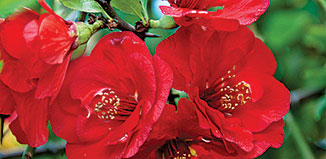
If our dreary cold weather is wearing you down, the sight of flowers on winter bare branches is sure to lift your spirits. Their colour-hued silhouettes against the season’s grey skies are stunning and have the added bonus of looking good in a vase.
Wintersweet (Chimonanthus) and witch hazel (Hamamelis) have a gorgeous fragrance and subtle colouring which blends with any décor. But my favourite is the flowering quince (Chaenomeles) in lively lipstick-red. The blooms, like over-sized apple blossom, on bare, twisted branches are a welcoming sight, both in the garden and in a vase.
You can plant flowering quince as a low hedge or train its pliable branches against a wall or fence, just beware of the plant’s sharp spines. These are its only drawback, although they can deter unwanted foot traffic.
Flowering quinces belong to the rose family and are happy in sun or part shade. Almost neglect-proof, they can cope with hard frost, drought and clay soil.
Flower buds are produced on previous summer growth, so mid-spring, after flowering is the best time to prune, cutting out dead or damaged branches. You can rejuvenate an old plant by removing the oldest, fattest branches to ground level, although hard hacking is best avoided unless you want to create a dense thicket.
Some varieties produce green and yellow japonica apples that ripen in the autumn, if not removed with pruning. These have a lovely perfume and can be used to make jelly.
If you have a warm, sunny, sheltered spot, away from any threat of frost, you’ll be able to grow Luculia gratissima ‘Early Dawn.’ This showy shrub flowers in early winter with an absolute cloud of soft pink flowers and a sweet, pervasive fragrance.
The waxy flowers are held in big, round bunches, dark rose in bud, and a baby pink when open. Plant it in pride of place, not too far away from a window so its wonderful perfume can waft indoors.
The shrub grows quickly to two or three metres and its best to prune it back by about a half every spring, once the risk of frost had passed. This keeps growth lush and bushy and maximises flowering. Unpruned shrubs grow tall and leggy with flowers at the top.
Another winter favourite of mine is Daphne ‘Alba’ – such delectable winter fragrance on a modest-sized, neat and tidy bush with attractive green foliage.
A sprig in a small vase banishes the winter blues feeling, emitting a perfume that belies its size and beats anything you can buy in a bottle. In the garden the perfume is so strong you don’t need to bend down to enjoy it – if I had room I’d plant a whole row.
Like camellias, daphnes like cool, lime-free soil, rich in organic matter. They hate wet feet, so good drainage is paramount. If you have heavy, damp soil, it’s best to plant daphnes in raised beds or pots.
Avoid placing your daphne in direct all-day sun because this will turn the leaves yellow. Nutrient imbalances caused by high pH or poor drainage can also result in sickly, yellow leaves. If yellow leaves persist in well-drained soil, iron deficiency may be the problem. This can be remedied with a dose of iron chelates.
Kept compact with a light prune after flowering, this is an attractive year-round shrub that flowers its socks off just when you need it the most.

